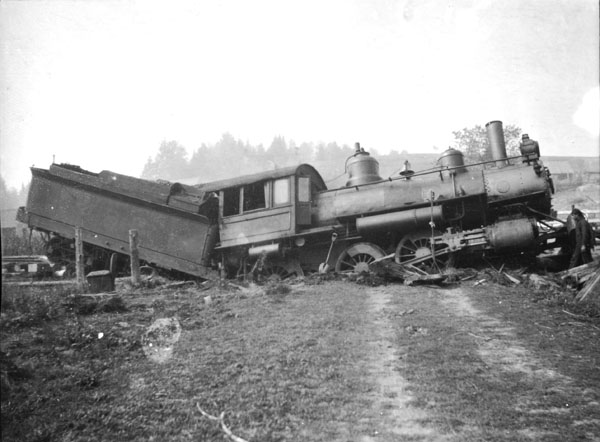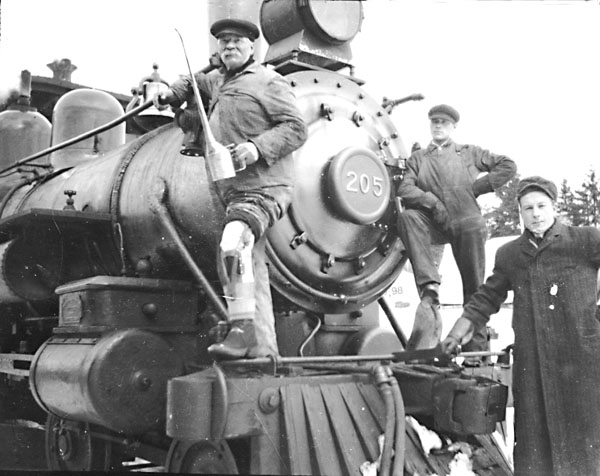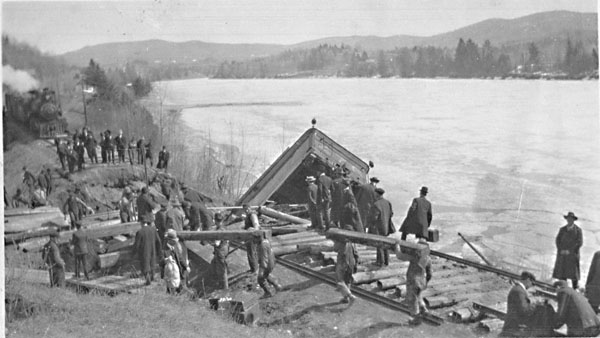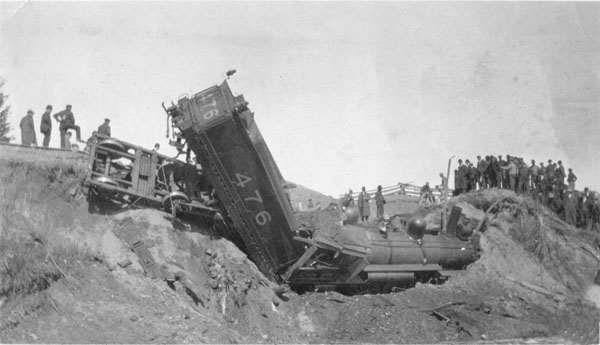In the graveyard of the United Church at Norway
Bay, in west Quebec, a simple stone marks the grave of William McFall who
died in April 1911 at the age of 61. The inscription may have been simple
but William McFall’s life was far from it and he died a hero.
Born at Bristol, Quebec, in 1850, he had always wanted to go railroading but there were no railroads in west Quebec at that time. However, across the Ottawa River, in Ontario, the Brockville and Ottawa Railway was slowly building its line from Brockville, through Smiths Falls to Arnprior, Renfrew and Sand Point. So he signed on around 1871 with the Brockville and Ottawa and was soon out firing. It was tough in those days. The locomotives were wood fired and this was rough on the hands. It was pretty dangerous too. Many train hands lost their footing and were killed under the wheels while most brakemen and conductors had lost at least one finger to the link and pin couplers. But it was the Gatineau Valley Railway with which he became associated. It eventually ran northwards from Hull through Wakefield to Maniwaki, Quebec and became well known in more recent years for the steam excursions to Wakefield operated initially by the National Capital Commission and now by the Hull-Chelsea-Wakefield Railroad. This line had a number of false starts and it was not until 1889 that construction commenced in earnest between Hull and Wakefield, then known as Peche. Mr. McFall hired on to drive the construction trains. The first passenger train on the Gatineau Valley Railway was a special to conduct government engineers on a tour of inspection on 17th December 1890 and William McFall was at the throttle. This trip, and several others like them, were very important indeed because a favourable report would allow the government to release some subsidy money to the cash-strapped line. By driving the locomotive carefully, the engineer could help to give the impression of a smooth, well-built, road. Not all inspection trips were as smooth as the first one. On 25 May 1891 the locomotive was running tender first and the tender derailed some two miles above Chelsea. Initially the directors tried to pass this off as a stop to admire the scenery but a gang of men and a locomotive had to be sent for. Some two hours later the tender had been rerailed and the train was drawn back to Chelsea where the original engine was put on one side and the inspection continued with the second locomotive. Needless to say passenger operation was not allowed for some time after this incident. With the opening of regular service to Farrelton in February 1892, Mr. McFall ran the passenger train. This ran into the Canadian Pacific station at Broad Street in the Chaudiere district and his locomotive was housed at the C.P.R. round house. He had a house on Preston Street which was very convenient for his work. For the extension of the line to the Pickanock River (the station was named Wright) in December 1893 it was McFall, again, who drove the special train for the inspecting engineers and newspaper men. By 1895 he was running the passenger train between Ottawa and Gracefield which remained the terminus for almost nine years. The year 1901 was a momentous one for William McFall. On 22nd April, he brought the first service train across the brand new Interprovincial Bridge and into the Canada Atlantic Railway Central depot on the site where the Grand Trunk Railway Union Station would be built some ten years later. His train had been repainted and was gaily decorated with flags especially for the occasion. There was quite a party at Hull waiting to board the train, including most of the officers of the line. It was important to get in on time but this wasn’t made any easier by old Mrs. Valiquette of the Cottage Hotel in Hull who insisted on breaking a bottle of wine on his engine as it entered the bridge. McFall, waved to the crowds who thronged Nepean Point and Dufferin Bridge to witness history being made. 
The Gatineau Valley locomotives were now serviced at the C.A.R. round house in Ottawa East, rather than in the C.P.R. round house in the Chaudiere and this made the journey to work from Preston Street a little longer. But his trips to Gracefield soon began to feel like routine. However, the routine was broken on 14th June 1901 when an axle on the tender broke as he was pulling away from the Hull station on his way up the Gatineau. McFall quickly applied the brakes and managed to stop the train within about 40 feet. They were still on the leg of the wye and, with another locomotive available in Hull, they quickly coupled it to the rear of the train, drew it up, backed down the wye, and were on their way again with only some twenty minutes delay. Another highlight of McFall’s career was the visit of the Duke and Duchess of Cornwall and York to Ottawa. Accounts indicate that he drove the locomotive of the Royal Train although there is no direct evidence in the papers to support this. On 24th September 1901 the royal party left Ottawa for Carleton Place and the west. There were two trains, the first carrying representatives from the press and guests while the second one followed, half an hour later, with the royal couple. They left by a circuitous route from the specially prepared Elgin Street station to Ottawa East then along the canal, through Central depot, past Nepean Point and across the Interprovincial Bridge to Hull. The section from Central depot to Hull was over the Ottawa, Northern and Western Railway (formerly the Gatineau Valley) and it is likely that McFall was in charge for this segment. Canadian Pacific locomotives were used and McFall likely accompanied C.P.R. engineer Glendenning who ran his regular locomotive as far as Chalk River. In May 1902, the Canadian Pacific Railway purchased the Ottawa, Northern and Western Railway and that same month, diverted the Gatineau trains away from the Canada Atlantic Central depot back into the C.P.R. Union depot at Broad Street in the Chaudiere. This was more convenient for McFall as his walk to work was much shorter but there were many complaints from the Gatineau passengers who preferred the more centrally located Central depot. For a short while, no trains used the Interprovincial Bridge, but C.P.R. were planning to re-route the transcontinental Imperial Limited, from the north shore route from Montreal via Lachute to the shorter M. & O. route via Rigaud. Although C.P.R. trains on the M. & O. route were using Central depot, the two companies were squabbling over the use of the C.A.R. station, and so on 31st May 1902 Sir Thomas Shaughnessy, the C.P.R. president, planned to make a tour of inspection from Montreal to Ottawa via Rigaud. His private car was to be attached to the westbound Imperial Limited at Broad Street and there would be a special move across the Interprovincial Bridge over the proposed new route of the transcontinental train. William McFall, who was now a C.P.R. employee, was called specially to make the transfer move and the Canada Atlantic were informed the day before. He backed his engine slowly across the Interprovincial Bridge in good time to meet the president’s schedule. Coming up to Sappers Bridge at the north end of the Central depot, McFall was surprised to find a stop block had been placed on the track and the connection removed. As soon as it heard about the C.P.R. plans the Canada Atlantic had quickly, at night and under floodlights, removed the track and installed a stop block. McFall stopped quietly by the new stop block and wondered what to do. At 12.30 the C.P.R. train with the special car arrived at the Central depot. The president was quickly on the ground and speaking to Mr. P.W. Resseman, the O.N. & W. superintendent: “Have you your engine ready to take this special car round to the Union depot?” “I have,” responded the superintendent, “But the C.A.R. has torn up the crossover and put a standard stop block on the bridge, and there are those passenger cars on that track, so we cannot cross over except on the other side of Maria Street (now Laurier Avenue) bridge, and when we do cross over to the siding, those cars and the block are in our way.” Sir Thomas looked at C.W. Spencer, the general superintendent, pulled on his cigar and characteristically pulled his grey hat down on one side of his head. "Eh h'm," he said, "let us take a look at this thing anyway." He walked up within a hundred yards of the block, surveyed the situation at a glance, noticed where the crossover had, a few hours before, been torn up and smiled. "Well, I guess we won't be going over the bridge today by this route, will we?" said he, and he turned about to go back to his car. The immediate situation was resolved by taking the special car to Broad Street via Hurdman and Chaudiere Junction and the overall situation was resolved by the Board of Railway Commissioners but this was probably one of the easiest days in William McFall’s long railway career. The C.P.R. finished construction of the Gatineau line to Maniwaki in 1904 and William McFall brought the first train down on 8th February, the previous service train to Gracefield having been taken empty to Maniwaki. From now, his regular job was the evening passenger train from the C.P.R. Union depot to Maniwaki and the return to Ottawa the next morning. As with most of his railway life this didn’t give him much time at home but he and Roxy brought up a family of four daughters and two sons. He was a prominent Orangeman and active in the Order of Railway Engineers. On 11th February 1905 McFall was involved in an accident a few miles south of Low. Happily, it turned out to be not too serious, although it was a portent of things to come. It seems that the caboose on the rear of the train left the rails and dragged two cars with it. No sooner had they left the rails than they toppled over completely on their sides on the embankment nearly twenty feet from the track. The couplings gave way and the locomotive and baggage cars kept the rails. There were not many passengers on board, but these were thrown violently, and several of them badly bruised and cut by the broken glass. A more serious event occurred on 21st September 1908 at Aylwin. McFall was running his regular passenger train to Maniwaki and, on leaving Aylwin, he was preparing to have his normal snack. He stood on the tender facing the rear and opened the cupboard to retrieve his lunch pail as usual. However, on this day, someone had left the switch to the siding open, the engine and tender ran off the end of the siding and McFall was trapped by his left leg between the engine and tender. He was brought back to a house close to the station where the local doctor, Dr. Charles F. Gordon, was forced to amputate the lower part of his left leg (2). In those days, anesthetics were unknown, and all he was given was a couple of tots of rum while an onlooker held up an oil lamp so the doctor could carry out his grim work with a bone saw. When the saw cut through the bone completely the pain was so intense that McFall bit right through the stem of his pipe which he clamped into his mouth. 
The wreck at Aylwin where William McCall lost his right leg which was trapped between the engine and the tender.He was brought back to St. Luke’s hospital, Elgin Street, Ottawa and was able to return home a month later on 21st October. By this time, he was one of the oldest engineers on the C.P.R. and was given the opportunity to retire. But his love of railroading was too strong and it wasn’t very long before he returned to duty and his Maniwaki line, albeit with an artificial leg. 
William McFall oiling round his locomotive at Maniwaki and showing off his artificial leg. The man standing with one foot on his fireman’s shovel is fireman Hebert McConnell. The identity of the person in the long coat is unknown.Two and a half years later McFall was involved in his final accident, two miles north of North Wakefield, later known as Alcove. The Ottawa Journal of 15th April 1911 described it thus: “Thank Heaven they are Saved”. Thus exclaimed brave engineer McFall last night when told that his passengers had escaped. By the heroism of Engineer William McFall of the C.P.R., forty passengers were last night saved from death or serious injury in a wreck on the Gatineau line, about three miles from North Wakefield. The accident happened about 6.30. It was due to a washout on the line. The up train which leaves Ottawa at 5 o'clock, arrived at North Wakefield on time at 6.20. There were forty passengers on board and the train was in charge of Conductor T.F. Carter and Engineer Wm. McFall. About two hours and a half before, the down train had passed through safely, and sectionmen who went over the line afterward are said to have reported it in good shape. The recent thaws, and rain, however, had put Engineer McFall on his guard, and he was watching the line closely. About three miles from North Wakefield station he saw a gap in the track between fifty and a hundred feet wide and over 25 feet deep. He was almost upon it before he saw the danger. The Fireman jumped. Engineer McFall, however, stuck to his post, throwing on the emergency brakes and doing all in his power to stop the train. He succeeded as far as the train was concerned, but the engine toppled over into the hole and he had no time to escape. The passengers rushed out to see why the train had stopped and there was great excitement when they realized what a narrow escape they had had. Search was immediately made for the engineer who, it was feared, was under the engine, which, over ended and covered with clouds of steam, was lying in the bottom of the hole. Finally, McFall's body was seen lying on the ice of the river a few feet away. He was scalded from head to foot by the steam. Dr. Pritchard of North Wakefield was at once called and cared for the suffering man. 
A view of the washout at Alcove where McFall lost his life. A wrecking train has come down from Maniwaki and the proximity to the ice of the Gatineau river, in which McFall finished up is evident.He was brought back to St. Luke’s hospital in Ottawa, where he was attended by his wife. Mrs. McFall explained: “So far as I could gather from what my husband said the next he could recall was finding himself on the ground and suffering terribly from the effects of the hot water and steam. He told me that he jumped on the ice first and that it seemed to break under his feet and he went down in the water a short way. This considerably relieved the terrible pain from the burns. He was later on pulled from the water by some of the passengers and was greatly relieved when told that none of the passengers had been injured. Exclaiming, "Then Thank Heaven they are all saved." he next enquired for the safety of his fireman. The latter had escaped uninjured.” (3) Conscious to the last and fighting hard against death with that indomitable heroism which characterized his life, Engineer William McFall passed away in St. Luke's hospital at an early hour Sunday morning 17th April 1911. In Erskine church that evening Rev. Kennedy Palmer told in touching terms of a talk which he had had Saturday afternoon with Mr. McFall. "Well, Mr. McFall, we are all proud of you, you did your duty," said Mr. Palmer. "I tried to," replied the dying hero. After a little further talk by Mr. Palmer, Mr. McFall said: "I am not afraid to die. If it is God's will, I am ready. There is an advocate between us and God." And then Mr. Palmer left him, never to see him alive again. The funeral took place on Monday 18th April 1911 from his late residence on Preston street, to Union depot where a special train ran to Maryland for interment at Norway Bay. 
Another view of the fatal washout showing the locomotive embedded in the fill with the tender balancing precariously in the air. There are two trucks visible under the left hand end of the tender. The smaller truck is the tender truck itself while the longer one underneath the tender truck is from the baggage car. The body of the baggage car finished up overhanging the gap but was removed before this picture was taken.The Ottawa Citizen editorial on 18th April 1911 is worth quoting. "The death of engineer William McFall as a result of injuries received by bravely staying on his engine and doing his utmost to stop the train which was plunging into a washout on the Gatineau road, is one of those incidents that inspire admiration and respect for railway engineers as a body. Engineer McFall was an elderly man and had already been maimed in a previous accident, resulting in the loss of a foot. Yet, with unshaken nerve, he continued his work, and when again he was unfortunate enough to meet disaster, through no fault of his own, he courageously met death in order to ensure the safety of the passengers. This would appear to be a case which should be brought to the attention of the Carnegie Fund Commission." In fact, the Governor General made a recommendation to the King. I will end this account of a true railway hero with an extract from The London Gazette of 22 September 1911. Whitehall, September 21, 1911 His Majesty the KING has been graciously pleased to award the Edward Medal of the First Class to Mrs. McFall, the widow of the late William McFall, an engine driver on the Canadian-Pacific Railway, under the following circumstances:- On the 14th of April, 1911, a passenger train from Ottawa was approaching North Wakefield when the driver McFall suddenly perceived a gap in the track between 50 and 100 feet wide and over 20 feet deep caused by thaws and rain. The fireman jumped off the engine, but McFall put on the emergency brakes and sticking to his engine managed to bring the train to a standstill. The engine, however, fell into the gap, and McFall received terrible injuries, from which he died. There were forty passengers on the train, and had it not been for McFall’s heroic devotion to his duty serious loss of life would probably have occurred. Footnotes (1) Special thanks to William Felton McConnell for his detailed local knowledge. Ottawa Citizen – 17 Dec. 1890; 10 Nov. 1893; 23 Apr. 1901; 22/23 Sep. 1908; 29 Oct. 1908; 15/18 Apr. 1911; 30 Mar. 1946. Ottawa Journal – 26 May 1891; 10 Nov. 1893; 22 Apr. 1901; 14 Jun. 1901; 2 Jun. 1902; 8 Feb 1904; 13 Feb 1905; 15/17/21 Apr. 1911. Ottawa Free Press – 23 & 26 May 1891. London Gazette 22 Sep. 1911. (2) Although newspaper reports indicate that only the foot was amputated, photographic evidence indicates that a large part of the leg was removed. (3) Accounts of the accident vary. The Citizen reported that the fireman, too, stayed on the engine. Bytown Railway Society, Branchline, May 2005. |
![]()